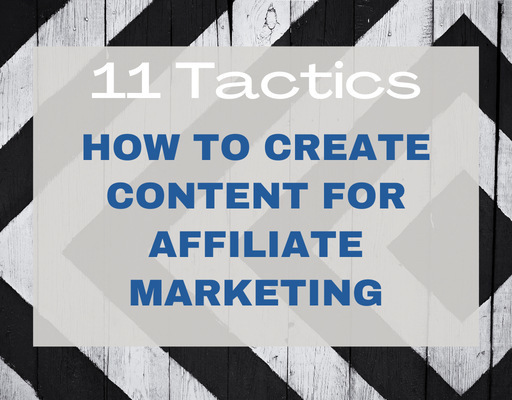Now is the time to take all previous experiences we’ve had with affiliate marketing and start putting pen to paper, so to speak. Let’s talk about how to create content for affiliate marketing with these 11 tactics you can use now.
Creating content for affiliate marketing can be time-consuming and overwhelming. It’s hard to know where to start, what kind of content to create, and how to make your content optimized for search engines. So with this guide, you can learn how to create winning content quickly and easily, that is SEO-friendly, engaging, and persuasive – all while saving you time and money!
- 1. What does your Audience Care About?
- 2. Use Keywords with Buyer Intent
- 3. Always Be Honest
- 4. Tell a Story – Draw in your Reader
- 5. Keep your Content Fresh
- 6. Learn About the Different Types of SEO
- 7. It’s OK to Leave a Negative Review
- 8. Focus on the Popular Products in your Niche
- 9. Be Consistent with your Posting
- 10. Keep your Content Relevant
- 11. It’s important to always Disclose Affiliate Links
- Wrapping Up – How to Create Content for Affiliate Marketing
1. What does your Audience Care About?
a. Are you making your articles engaging?
No one wants to read bland drivel with nothing but fluff content. Readers want to know the specific answers to their questions and maybe learn the answers to questions they weren’t even thinking about before they came across your blog.
b. Does your article have an optimized format?
Not many people out there like to read large walls of text. When people read, most scan the content, they aren’t looking at every word. So, it’s a good idea to make your articles scannable. To do: use bullet points, bold words, use small paragraphs.
c. Is your content adding value?
This is the main point, people want value. Nobody will read your blog if they deem it a waste of time. Try not to make articles full of content that is just trying to reach a word count.
2. Use Keywords with Buyer Intent

Back when we were doing keyword research, we came across two different types of keywords. Ones with informational value like “what is affiliate marketing?” These are helpful, and informational and build trust with your audience.
Then you have keywords with commercial value like “buy iPhone online” or “what is the best smartphone?” These are your buyer intent affiliate links.
When you wonder how to create content for affiliate marketing, you want to base your posts around these buyer intent keywords.
Here you talk about the products you’ve used (or researched) and give your opinion, but you must be careful to be authentic and not salesy.
Examples of Buyer Intent Keywords
- Buy Carhartt Mens Loose Fit Heavyweight Short-sleeve Pocket T-shirt
- Where to buy Wyze Cam Spotlight Security Camera
- Online Solar Panel Store
- POLDR Binoculars review
- Fitbit sale
Serpstat goes one step further than commercial and names the best buyer keywords as transactional, where the person is at the end of the buying funnel.
Serpstat Keywords
- Informational – helpful articles that are often questions: ‘How to…?’, ‘difference between…’
- Navigational – articles include ‘where is…?’
- Commercial – articles include product or service names, comparisons between products, lists, and reviews
- Transactional – imminent action articles ‘buy now’ and ‘for sale’
Serpstat on Transactional Keywords
These searches can happen after someone has already searched for information, made a decision, and is determined to now take a specific action or make a purchase. Such keywords often feature words like “buy,” “subscribe,” “for sale.” You’ll probably also see Google Shopping ads in these searches.
Serpstat
3. Always Be Honest
Remember this is a business you’re building, and you want your most valuable asset to be your brand. That means you’ll need some weight behind what you say.
If you give a shoddy program a great review because you want the affiliate income, people will start to pick up on that, and you’ll lose their trust.
You can say you don’t recommend this program and recommend another one. Tip: still include the affiliate links for both programs. Some people may still buy the one you don’t recommend!
It’s much easier to pick a better affiliate offer than to rebuild your reputation, so start things off the right way and be honest, and stay on the path to success.
4. Tell a Story – Draw in your Reader
An easy way to make your post engaging is to tell stories. Storytelling is probably the oldest form of entertainment in human history, and it’s just as effective as ever. If you can tell a story about a time you used a product and it made your life better, you are on your way to your first affiliate sale.
Storytelling is key when learning how to create content for affiliate marketing. This is one of the most important factors in learning how to write a blog post for beginners.
5. Keep your Content Fresh
Consider the different kinds of content when deciding how to produce your affiliate marketing material. Although it’s critical to consider your audience, vary the types of articles you create. Each audience does not read the same sort of article.
It’s going to get tiring constantly publishing 1000-word-long product reviews. To keep your audience engaged and your material fresh, vary the length and style of your postings. Listicles, Q&As, reviews, comparison posts, and how-to manuals are some of the options. The possibilities are endless!
All of these have the potential to be excellent sources of affiliate income. Using them all regularly will improve your conversion rate.
Tips:
- Headings are your friend
- Bullets make content scannable
- Keep paragraphs short and sweet
- Make it easy to skim your posts
- Add ratings
- Adds stats and facts
- Add videos from YouTube – these don’t have to be your videos
- Add images to break up the text
6. Learn About the Different Types of SEO

SEO doesn’t stop at keyword research. There are a few other things to get familiar with when learning to write a blog post for beginners.
You are going to have to learn about on-page SEO, which is optimizing the things you can control on your sites, like page speed, accessibility, alt-tags on your images, use of H1-H5 headings, internal and external links, etc.
Off-page SEO is a bit out of your control, like social media mentions and backlinks. While these are very important, they come with time and authority. A good habit is to always share your posts on social media straight after you’ve published them.
Tip: Add your newly published posts immediately to Google Console URL inspection to get them indexed faster.
All of these factors are important when learning how to create content for affiliate marketing.
7. It’s OK to Leave a Negative Review
You won’t love every product you review, and your readers know that. If everything in your blog gets 5 stars, your readers will probably feel that you are not being authentic and start to look for opinions elsewhere.
While you don’t want to go overboard with negative reviews, be authentic as possible, and people will be able to tell
8. Focus on the Popular Products in your Niche

The point of affiliate marketing is to provide a service, not sell a product. What I mean by that is your customer should be the focus of your affiliate campaign.
If you aren’t concentrating on advice, items, services, and offerings that your customers will enjoy and find helpful, you’re off course.
While we’ve previously stated that it’s critical to highlight only the products you like, it’s even more important to focus on the items your followers will be interested in.
If you’re promoting products that nobody wants, it doesn’t matter how great a salesperson you are. You’re not going to make any money. So, before you start your affiliate marketing campaign, do some research and find out what products or services your target audience is interested in.
When this occurs, it’s critical to put your consumers’ wants first since they are the ones who benefit from affiliate marketing. With this in mind, strive to give rundowns on things that will improve your readers’ lives.
They’ll be grateful to you for it, and as a result, you’ll be a much more successful affiliate.
9. Be Consistent with your Posting
The importance of content scheduling cannot be overstated. They offer the dependability and entice and retain your audience. Your readers will remember that you usually provide fresh new material on Tuesdays and Thursdays, and will check your site regularly. Consistency goes a long way in learning how to write a blog post for beginners.
Readers would be turned off if you published chaotically. If they visit your site and see the latest post is from three weeks ago, they will probably never come back.
Scheduling also allows you to take advantage of trends. Suppose you see a hot topic in your industry that you can write about. In that case, you can quickly publish an article on that hot topic and get in front of your audience while it’s still relevant.
10. Keep your Content Relevant
Know your consumers well if you want to produce flourishing content for affiliate marketing. What have your readers already heard about your product and company? What additional information do they anticipate discovering on the internet?
If you write about a new topic, such as pet tech gadgets, provide comprehensive details. People want to know how these devices appear, how they function, whether they are safe, etc.
Don’t try to cover all of the features in one post when reviewing a product with dozens of options. To begin with, you should concentrate on the qualities that may influence your readers’ purchasing decisions.
If you’re writing about hiking shoes, you don’t need to go into detail about the leather quality. You should share your own experience with your readers rather than just telling them what they want to hear. You should address the most pressing issues that customers have. Focus on the benefits, not the features.
11. It’s important to always Disclose Affiliate Links
The Federal Trade Commission has rules in place for affiliate marketers.
While the FTC rules are pretty strict, they boil down to this: you must clearly disclose any connection with a brand, merchant, or product on your website. Furthermore, the disclosure must be noticeable, especially near a point of purchase or an affiliate link.
Wrapping Up – How to Create Content for Affiliate Marketing
It is not too difficult to learn how to create content for affiliate marketing. Remember to approach it by helping customers, not selling products. Try not to give readers any reason to leave your page.
- Make valuable content
- Make your posts easy to read
- Make your content engaging
Readers will only come back to your site if they feel it’s worth it. Concentrate on adding as much value as you can to your posts. Tell stories about your experiences with the products you are talking about. That’s a lot more effective than giving readers a list of features.
Vary your content to make your site as a whole interesting to read. Be honest when you come across products you don’t like. That’ll keep your readers coming back if they feel like you’re genuine when you speak about things.
Make your content easy to read, and don’t give people any excuses to leave because they’ll take it. It doesn’t matter how great your writing is. If it’s a wall of text, people won’t take the time to discover it.
Regularly give your readers new content. Allow readers to add you to their routine, and you’ll always have an audience. It’s essential to continue writing the content that made your blog successful in the first place. Your fans will be looking forward to your next post, and if you don’t deliver, they will find someone who will.
You can be a successful affiliate marketer, but it will take some consistency. You have everything you need to get started; now, you just have to decide to make it happen.
READ MORE
- 6 Best Website Builders for Your Online Business
- 6 Best Online Life Coaching Platforms
- Market Your Coaching Business Without Spending a Fortune
- 15 Essential Resources for Life Coaches (Paid and Free!)
- How to Create Your Irresistible Life Coaching Offer
- 7 Best Online Coaching Platforms
Photos by NisonCo PR and SEO and freestocks on Unsplash






